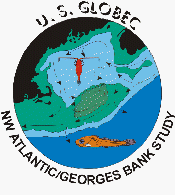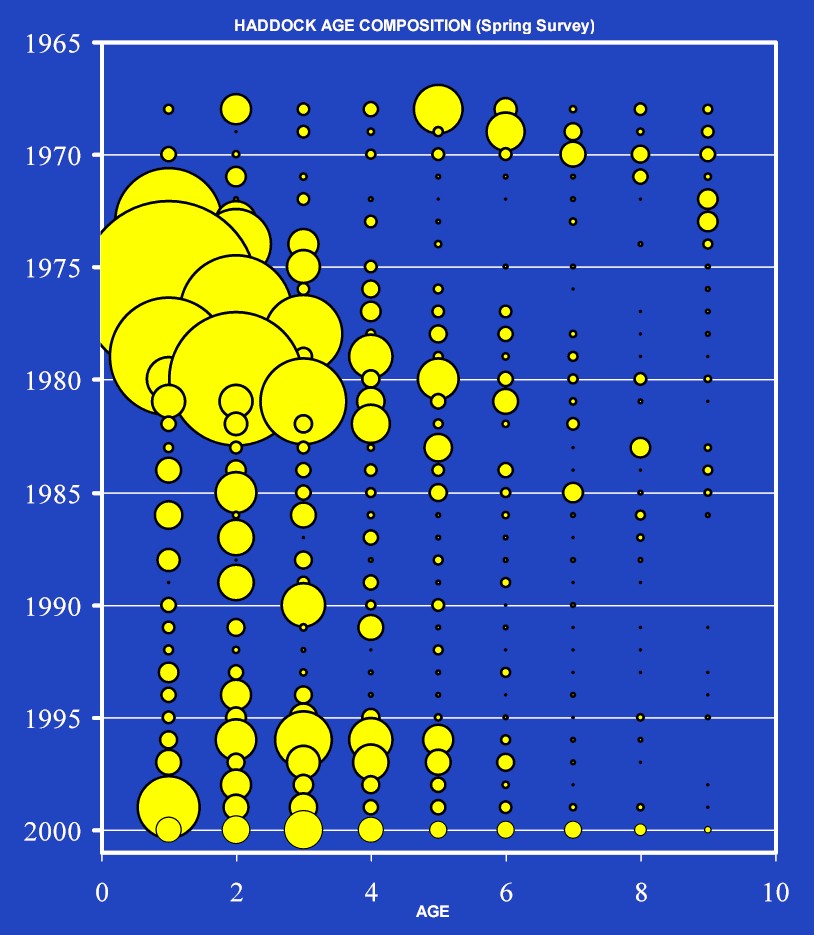Georges Bank Program Update
 The Georges Bank Program has recently gone through preparation and submission of Phase IV Synthesis proposals. These activities
provided an opportunity to outline a series of workshops and products planned for the next four to five years. Bob Beardsley(WHOI)
provided the update.
The Georges Bank Program has recently gone through preparation and submission of Phase IV Synthesis proposals. These activities
provided an opportunity to outline a series of workshops and products planned for the next four to five years. Bob Beardsley(WHOI)
provided the update.
Bob's presentation began with an overview of the Georges Bank Program including the
initial hypotheses and approaches of the Program. He then moved into a description of the field program which included a mesoscale
survey and a series of process cruises focusing on key features of the system. In 2000 a series of workshops
were held. Workshop
Reports are available online and include summary information such as the timing of events (rings, cruises, etc.). A preliminary
timeline for Phase IV has been developed and includes dates for workshops in 2002. A new Executive Committee will be set up for
Phase IV. The Georges Bank Program has produced a number of papers during the past year including Wiebe 2001, Borg et al. 2001, Chen and Lou
2001, Houghton et al. 2001, Lynch et al. 2001 and a special issue of Deep Sea
Research.
The discussion turned toward a recent development in
hydrodynamic modeling. Chen et al. have developed a finite volume modeling capability said to alleviate some of the problems noted
in passive tracer conservation of finite element models. Solutions to this problem have also been developed for finite element
modeling by Paul Budgel and Charles Hannah during the last year. Both finite element and finite volume models are featured in Phase
IV proposals. Dale Haidvogel commented on these different approaches by saying that there is a tradeoff between the resolution
afforded by the finite element models and the tracer conservation characteristic of the finite volume model. The Georges Bank
Program has had a substantial investment in finite element modeling which, when the program started, was one of the only suitable tools
available. A workshop to address the differences between finite element and finite difference models was suggested as an appropriate
avenue to explore this particular issue.
Bob presented results from Houghton's dye study on Georges Bank beginning with the observation that residual flow on the
Bank is driven by tidal rectification, upstream buoyancy and surface forcing. The details of hydrodynamic structure in a
modeling context is strongly dependent on topography and weakly on mixing parameterization. The dye study took place on the
Northern and Southern Flanks and indicated that the flow was coherent enough for the dye to be tracked for about 2 days.
On-bank transport (on the order of 20 cm s-1) was noted at the base of the tidal mixing
front and may play a role in retention and nutrient input onto the Bank. The dye dispersion provided an estimate of 20
m2 s-1 for Kx and 2 m2 s-1 for Kz. The Northern Flank,
with its steeper topography, had steeper fronts than did the Southern Flank.
 A discussion of the age structure of haddock on Georges Bank was presented
next. The 1998 and 2000 year classes of haddock were large and
may have been produced by an adult stock with a broad age distribution.
However, the 1998 year class is characterized by high survival rather than high
egg production. Furthermore, this year class cannot be explained solely by
increased survivorship through the egg stage. Processes later in the life
history are apparently important and remain, as yet, unidentified. It was noted
that 1998 was a year with high Calanus abundance. Other copepods were
also abundant. This year also had no incidence of ring activity.
A discussion of the age structure of haddock on Georges Bank was presented
next. The 1998 and 2000 year classes of haddock were large and
may have been produced by an adult stock with a broad age distribution.
However, the 1998 year class is characterized by high survival rather than high
egg production. Furthermore, this year class cannot be explained solely by
increased survivorship through the egg stage. Processes later in the life
history are apparently important and remain, as yet, unidentified. It was noted
that 1998 was a year with high Calanus abundance. Other copepods were
also abundant. This year also had no incidence of ring activity.
A book to follow up on the Richard Bakus Georges Bank book is proposed in the
last year of the synthesis phase. The structure of this book has not been
defined as yet. It would hopefully serve as a comprehensive review of the
system and the Program. Researchers should not save publishable material for
this volume however.
There will be no dedicated Georges Bank session at the AGU/ASLO Ocean Sciences Meeting this year due to the location and
timing of the upcoming SO cruises. There are however a number of suitable special sessions. In particular see OS02 Coupled Biophysical Processes, Fisheries Resources, and
Climate Variability in Coastal Ecosystems of the Northeast Pacific Ocean, OS27 Physics and Biology of Antarctic Continental
Shelf Waters, OS47 Marine Ecosystem Responses to Climate: The Responses of Large Marine Ecosystems to Interdecadal-Scale
Climate Variability.
Zack Powell noted that field programs would end across the board within a
few years. It might be profitable to begin thinking about what has been learned
from all the US GLOBEC regional programs and to coordinate synthesis
activities. Fogarty said that there would be a synthesis for the US GLOBEC
Program as a whole to bring together information from the regional programs.
Ideally, we should bring all GLOBEC programs into the process, including
international programs.
Elizabeth Turner provided an update on the Georges Bank synthesis proposals. Competition was vigorous. A total of 15 proposals were received. If
all were funded the cost of synthesis for Georges Bank would be $15 million, a figure exceeding current
budget.
 The Georges Bank Program has recently gone through preparation and submission of Phase IV Synthesis proposals. These activities
provided an opportunity to outline a series of workshops and products planned for the next four to five years. Bob Beardsley(WHOI)
provided the update.
The Georges Bank Program has recently gone through preparation and submission of Phase IV Synthesis proposals. These activities
provided an opportunity to outline a series of workshops and products planned for the next four to five years. Bob Beardsley(WHOI)
provided the update. A discussion of the age structure of haddock on Georges Bank was presented
next. The 1998 and 2000 year classes of haddock were large and
may have been produced by an adult stock with a broad age distribution.
However, the 1998 year class is characterized by high survival rather than high
egg production. Furthermore, this year class cannot be explained solely by
increased survivorship through the egg stage. Processes later in the life
history are apparently important and remain, as yet, unidentified. It was noted
that 1998 was a year with high Calanus abundance. Other copepods were
also abundant. This year also had no incidence of ring activity.
A discussion of the age structure of haddock on Georges Bank was presented
next. The 1998 and 2000 year classes of haddock were large and
may have been produced by an adult stock with a broad age distribution.
However, the 1998 year class is characterized by high survival rather than high
egg production. Furthermore, this year class cannot be explained solely by
increased survivorship through the egg stage. Processes later in the life
history are apparently important and remain, as yet, unidentified. It was noted
that 1998 was a year with high Calanus abundance. Other copepods were
also abundant. This year also had no incidence of ring activity.